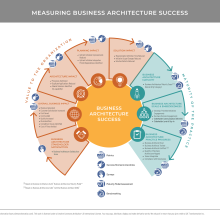In our last installment, Post No. 20, we looked at how to mature a business architecture practice with intention. On a related note, here in Post No. 21, we will talk about one of those million dollar questions: how to measure business architecture success.
Why do we need to measure our business architecture results in the first place?
Some business architecture teams have a lot of pressure to both build their practice and prove its value simultaneously. Even if you are not in this situation, there are many good reasons for you to measure and communicate your results. For example, all of your great stories and metrics will:
- Increase awareness and adoption of business architecture across the organization
- Expand the usage of and advocacy for business architecture in the organization
- Secure funding, resources and priority for business architecture activities
- Demonstrate the value of the investment to business architecture stakeholders (i.e. the business architecture leader(s) and other related teams)
Makes sense. So what do we measure?
In StraightTalk-style simplicity, generally two categories of things:
1. The value business architecture provides to the organization – This is the biggie that everyone wants to know about. This includes metrics like what overall impact business architecture is making in the organization (e.g. on customer satisfaction, revenue, cost savings, quality, etc.), how it improves planning and solution development, and generally how valuable people in the organization who use it say it is.
Super important: The metrics you choose here should align with the value proposition and scenarios you defined for business architecture in your organization. If you are struggling to identify the right metrics, it is likely because the way you’ve defined business architecture’s value to the organization was kind of fuzzy to start with. Post No. 2 can help.
2. The maturity of the business architecture practice – Not as hot of a topic as #1, but still really important. This includes metrics like how mature your business architecture practice is and how much progress you’ve made to establish it. It also includes how well it is embedded in and scaled across the organization.
How do we measure all of this?
There are different ways you can approach this and you will likely need a combination of formal and informal methods. For example, you can use metrics and surveys to help you get some hard data while supplementing it with success stories and anecdotes. From a practice perspective of course you have the maturity assessment (remember good ol’ Post No. 20) and even industry benchmarking to help you there.
Check out the handy diagram here to help you make sense of these categories of measurement (with just a few sample metric ideas to get you thinking) and the methods used to capture each.
Sounds good, but this seems a bit overwhelming.
Don’t let it be. As with any aspect of your business architecture practice, keep it practical and take it one step at a time. A few tips:
- Focus. Identify who really needs what information, when and how.
- Keep it simple to start. Just pick a few simple metrics that you care about and start measuring them. You can always get fancy later.
- Capture both qualitative and quantitative results. Don’t stress about getting perfect and robust metrics because that is just difficult to do with this discipline. Being able to tell success stories and quote advocates can be just as valuable as the numbers.
Share more about that.
While measuring the maturity and progress of a business architecture practice is relatively straightforward, on the other hand, measuring the value business architecture provides can be a little bit of a challenge. For example:
- Some business architecture results are intangible, like when it helps to inform decisions or create clarity
- Business architecture can lead to the avoidance of negative results, like that misaligned investment that you didn’t make or like that compliance issue which didn’t happen
- Business architecture results can be hard to isolate, because it is one discipline among many working together across the strategy execution ecosystem
- Business architecture results can create unwanted visibility for some people, so proceed with sensitivity when sharing results
Anything else?
Start measuring your business architecture results and successes from the very beginning—even if this just includes writing down a short success story of each engagement (e.g. what was the situation, how was business architecture used and what results were achieved).
If you approach measuring business architecture success in a simple manner, it is very doable and you will be glad to have the information in the future. And others in the business architecture community will love to learn from you. Happy measuring!
More Good Stuff…
Five Ways to Measure Business Architecture Performance (Jeff Scott): Industry Thought Leader Jeff Scott shares a number of methods used by business architects to measure success.
Measuring What Makes Life Worthwhile (TED Talk): A talk from Chip Conley on a business model based on happiness and how he learned that success comes from what you count.

